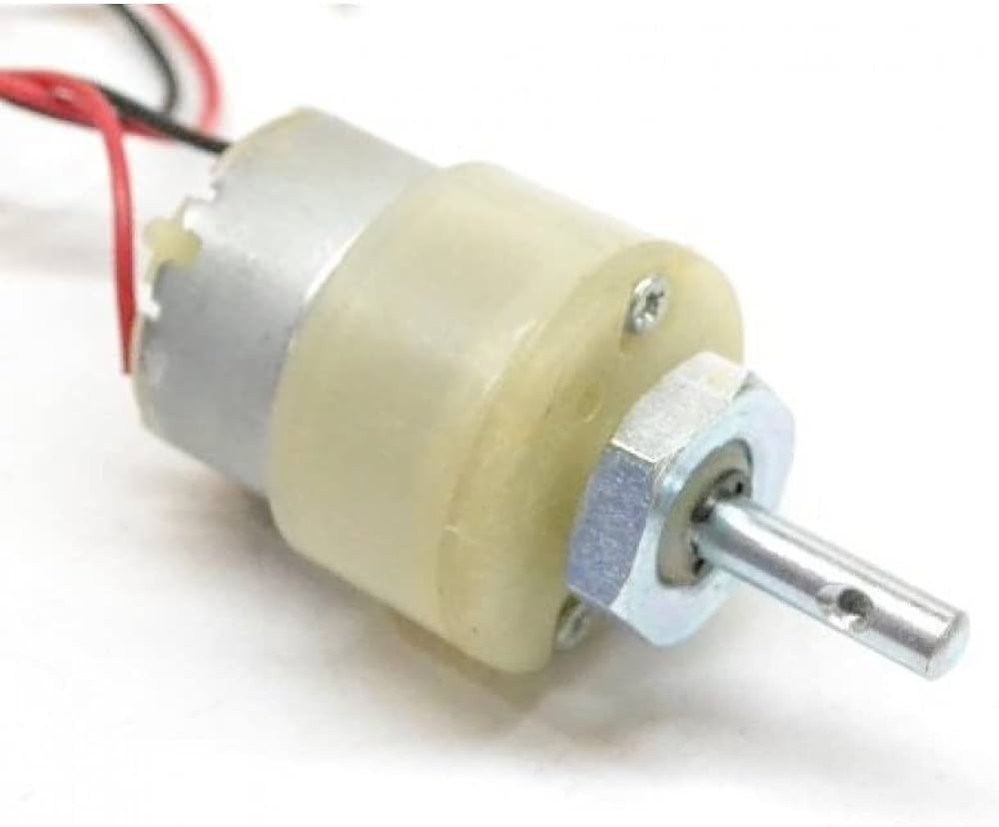





30 RPM DC GEAR MOTOR
This DC Motor – 30RPM – 12Volts can be used in all-terrain robots and a variety of robotic applications. These motors have a 3 mm threaded drill hole in the middle of the shaft thus making it simple to connect it to the wheels or any other mechanical assembly.
₹ 130 ₹149
149



| Made In : | India |
Add FAQ
A 30 RPM DC gear motor is a type of direct current (DC) motor that has a gear reduction mechanism to reduce the motor's speed to approximately 30 revolutions per minute (RPM). This type of motor is commonly used in robotics, automation, and various mechanical applications where precise control of speed and torque is needed. Here’s a comprehensive guide on understanding, selecting, and using a 30 RPM DC gear motor:
Key Features:
-
Speed:
- 30 RPM: The output speed of the motor after gear reduction. This is significantly slower than the motor's original speed due to the gear reduction.
-
Gear Reduction:
- Purpose: Reduces the motor's speed while increasing the torque. The gear ratio determines how much the speed is reduced.
- Type: Gears can be spur gears, planetary gears, or other types depending on the motor's design.
-
Voltage:
- Common Voltages: Typically available in 6V, 12V, or 24V. Ensure compatibility with your power supply.
-
Torque:
- High Torque: Gear motors provide higher torque at lower speeds, which is useful for driving wheels or other load-bearing components.
-
Size and Mounting:
- Dimensions: Available in various sizes. Ensure the motor fits in your project or application.
- Mounting: Check for mounting options such as brackets or flanges that are compatible with your setup.
-
Output Shaft:
- Type: Can be a plain shaft, keyed shaft, or D-shaft. Ensure compatibility with your coupling or mechanical linkages.
Applications:
-
Robotics:
- Drive Systems: Used to drive robot wheels or tracks where low speed and high torque are needed.
- Actuators: For mechanical movements requiring controlled speeds.
-
Automated Systems:
- Conveyors: Suitable for driving conveyor belts at low speeds.
- Positioning Systems: For precise positioning tasks in automation.
-
DIY Projects:
- Hobbyist Robots: Ideal for hobbyist projects requiring slow and controlled movement.
- Model Railroads: Used in model trains and other scale models.
-
Home Appliances:
- Electric Door Openers: Suitable for applications requiring low-speed, high-torque movement.
Selecting the Right Motor:
-
Speed Requirement:
- RPM: Ensure the motor's speed (30 RPM) matches the requirements of your application.
-
Voltage Compatibility:
- Power Supply: Choose a motor with a voltage rating that matches your power supply (e.g., 12V).
-
Torque Needs:
- Load: Consider the torque output to ensure it can handle the load you intend to drive.
-
Size and Mounting:
- Fit: Ensure the motor’s physical size and mounting options fit within your project’s constraints.
-
Gear Ratio:
- Speed and Torque: The gear ratio affects the motor's output speed and torque. Ensure the ratio suits your needs.
Installation and Use:
-
Mounting:
- Secure: Mount the motor securely using the provided brackets or mounts. Ensure it is aligned properly to avoid mechanical issues.
-
Wiring:
- Connect: Connect the motor to a compatible power source. Ensure proper connections to avoid short circuits or damage.
-
Control:
- Speed Control: Use a motor driver or controller if you need to vary the speed or direction. Some applications might require PWM (Pulse Width Modulation) control.
-
Load Testing:
- Check Performance: Test the motor with the intended load to ensure it performs as expected and does not overheat.
Maintenance Tips:
-
Inspect Regularly:
- Check for Wear: Inspect the motor and gears for signs of wear or damage.
- Clean: Keep the motor and surrounding area clean from dust and debris.
-
Lubricate Gears:
- Smooth Operation: Periodically check and lubricate the gears if required.
-
Monitor Temperature:
- Prevent Overheating: Ensure the motor does not overheat, which can indicate an overload or mechanical issue.
Purchasing:
- Retailers: Available from electronics suppliers, robotics parts stores, and online retailers like Amazon, eBay, and specialty robotics suppliers.
- Specifications: Verify the motor's speed, voltage, torque, and dimensions to match your project requirements.
Example Products:
-
12V 30 RPM DC Gear Motor:
- Material: Typically metal or plastic.
- Features: Gearbox with a 30 RPM output at 12V.
-
6V 30 RPM DC Gear Motor:
- Material: Often used in small-scale projects.
- Features: Lower voltage suitable for battery-operated systems.
By selecting the right 30 RPM DC gear motor and installing it correctly, you can ensure precise control and reliable performance for your robotics or mechanical projects.
0 Reviews For this Product





3.jpeg&width=225&quality=80)







